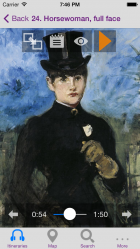
Rubens is the most famous Flemish painter of the 17th century. He was an exponent of the Baroque style and the Spanish court possessed a magnificent collection of his work, housed today in the Prado Museum. This was the consequence of his political links with Spain, because the daughter of King Philip II of Spain, Isabel Clara Eugenia, was the ruler of the Netherlands at the time.
One of Ruben´s favourite themes was mythology, as in this painting dedicated to Venus and Cupid. In it, we can see the strong influence of Titian in the handling of light, composition and colour. The goddess´s beauty is reflected in the mirror that is being offered to her by her son, Cupid, the fruit of her union with Mars. The same subject appears in Velázquez´s Venus with a Mirror, but handled in a very different way.
The goddess is seated, half-dressed in a white tunic and with one breast uncovered. She is enveloped in a red cape that provides the strongest note of colour in the picture. Her face and hair conjure up the Renaissance ideal of beauty, despite the fact that Rubens was an entirely Baroque artist. The hand holding the tunic is elegant, and reminiscent of El Greco, although far more sensual.
(c) (R) 2013, MUSMon com S.L.
Text (a) Catalina Serrano Romero
RUBENS - Venus y Cupido
Rubens, es el más famoso pintor flamenco del siglo XVII, representante del estilo barroco y del que la corte española poseía una magnifica colección, hoy día alojada en el Museo del Prado. Esto fue posible gracias a su vinculación política con España, ya que Isabel Clara Eugenia, hija de Felipe II, era la soberana de los Países Bajos.
Dentro de los temas preferidos por Rubens destaca el mitológico como el de esta obra dedicada a Venus y Cupido. En ella podemos apreciar la fuerte influencia de Tiziano en el manejo de la luz, en la composición y en el color. La belleza de la diosa se refleja en el espejo que le ofrece Cupido, su bello hijo, nacido de su unión con Marte. El mismo asunto aparecerá en la Venus del espejo de Velazquez, pero tratado de un modo muy diferente.
La diosa aparece sentada y semicubierta por una túnica blanca que le deja al descubierto un pecho. Está arropada por una capa roja que es la nota de color más importante del cuadro. Su rostro y su cabello evocan la belleza ideal del Renacimiento pese a ser un artista plenamente barroco. Es muy elegante la mano que sujeta la túnica, que nos recuerda a las manos del Greco, pero mucho más sensuales.
(c) (R) 2013, MUSMon com S.L.
Text (a) Catalina Serrano Romero
Picture
Source: Wikimedia Commons
Author: DcoetzeeBot
Permission: This artwork is in the public domain: The author of this artwork died more than 70 years ago. According to E.U. Copyright Law, copyright expires 70 years after the author's death. In other countries, legislation may differ.
Independently produced by MUSMon.com, the audio guide for the Thyssen-Bornemisza Museum offers you a wide-ranging, light-hearted and educational tour of one of Spain’s most outstanding art museums. It contains 90 minutes of commentary, illustrated with over 52 high-quality images, so you won’t miss a single detail during your visit.
We will guide you on your journey through the history of painting. +info




































































